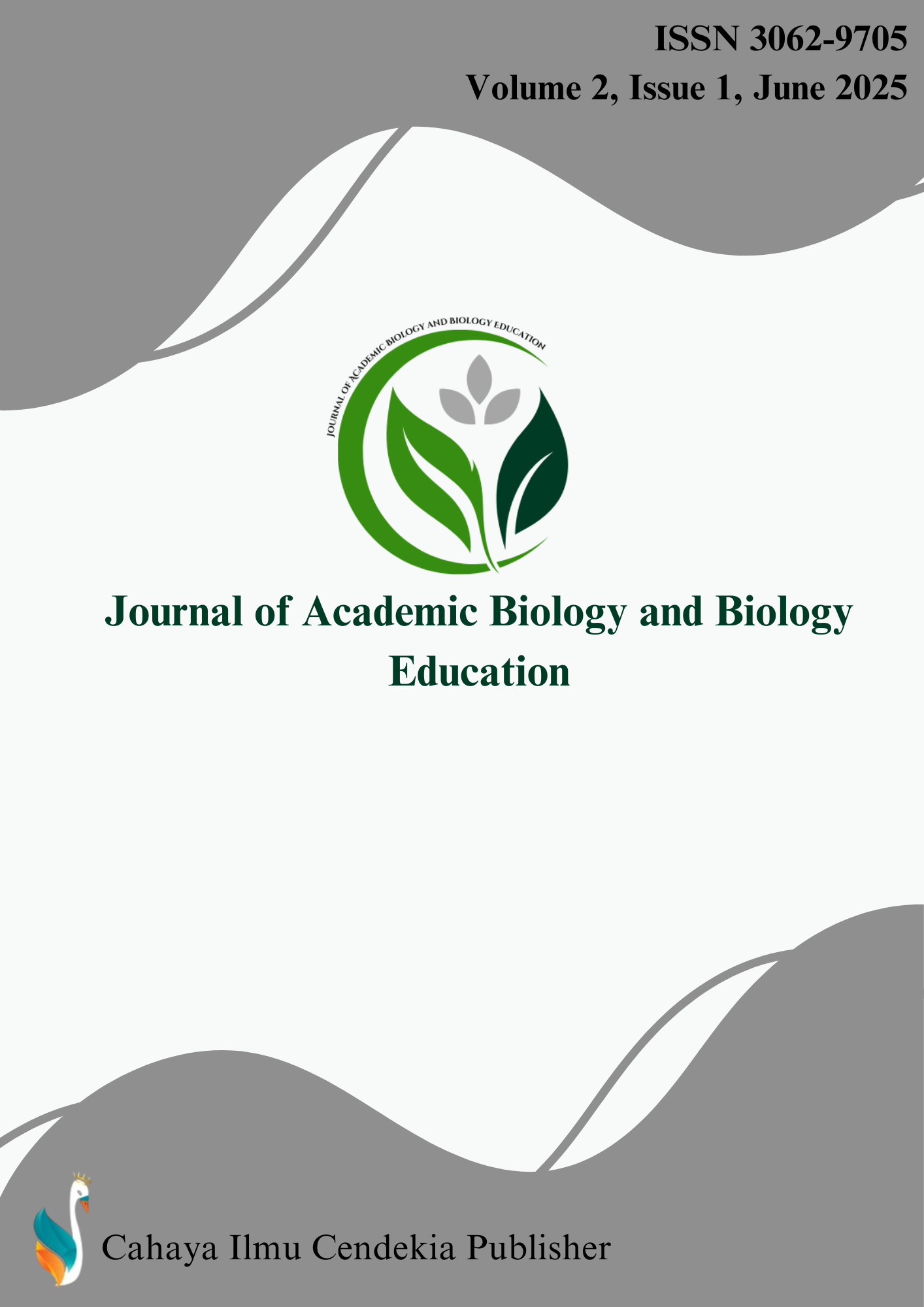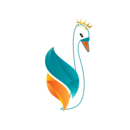Enhancing Plant Diversity Learning with an Ethnobotany-Based E-Booklet: A Focus on the Pandeglang Community
Abstract
Purpose of the study: This study aims to develop an ethnobotany-based e-booklet of the Pandeglang community as a supplementary teaching material on plant diversity material for grade X high school students.
Methodology: The method used is development research with the ADDIE model, which in this stage is focused on the analysis stage. The analysis was carried out on the concept of the material through concept maps from high school and Campbell Biology books, basic competencies and indicators, and medicinal plant data obtained through interviews and literature studies.
Main Findings: The results of the analysis show that there is a match between the material between high school books and international reference books, especially on Bryophyta, Pterydophyta, and Spermatophyta. In addition, 48 types of medicinal plants were obtained that are commonly used by the Pandeglang community and are relevant to be included in the e-booklet.
Novelty/Originality of this study: The novelty of this study lies in the integration of local ethnobotanical knowledge into digital learning media based on e-booklets that are contextual and easily accessible
References
K. von Rintelen, E. Arida, and C. Häuser, “A review of biodiversity-related issues and challenges in megadiverse Indonesia and other Southeast Asian countries,” Res. Ideas Outcomes, vol. 3, Sep. 2017, doi: 10.3897/rio.3.e20860.
C. O. Webb, J. W. F. Slik, and T. Triono, “Biodiversity inventory and informatics in Southeast Asia,” Biodivers. Conserv., vol. 19, no. 4, pp. 955–972, Apr. 2010, doi: 10.1007/s10531-010-9817-x.
N. S. Sodhi, M. R. C. Posa, T. M. Lee, D. Bickford, L. P. Koh, and B. W. Brook, “The state and conservation of Southeast Asian biodiversity,” Biodivers. Conserv., vol. 19, no. 2, pp. 317–328, Feb. 2010, doi: 10.1007/s10531-009-9607-5.
G. Windarsih et al., “Pragmatical utilization of beneng taro (Xanthosoma undipes) based on local knowledge of the community of Mount Karang, Pandeglang, Indonesia,” Biodiversitas, vol. 24, no. 12, pp. 6415–6424, 2023, doi: 10.13057/biodiv/d241202.
R. P. Lukodono and C. J. Lin, “Arm muscle activation performance analysis using machine learning algorithm in the assembly system,” Int. J. Hum. Mov. Sport. Sci., vol. 11, no. 6, pp. 1297–1304, 2023, doi: 10.13189/saj.2023.110613.
G. E. Uno, “Botanical literacy: what and how should students learn about plants?,” Am. J. Bot., vol. 96, no. 10, pp. 1753–1759, Oct. 2009, doi: 10.3732/ajb.0900025.
N. R. Anggraeni, S. Sriyati, and Amprasto, “Making teaching materials by utilizing the Cibodas Botanical Garden in an effort to improve plant literacy and classification skills of high school students,” J. Phys. Conf. Ser., vol. 1806, no. 1, p. 012154, Mar. 2021, doi: 10.1088/1742-6596/1806/1/012154.
T. Ningsih, D. M. Yuwono, M. S. Sholehuddin, and A. W. B. Suharto, “The significant of e-assessment for indonesian literacy with character education in pandemic era,” J. Soc. Stud. Educ. Res., vol. 12, no. 4, pp. 231–256, 2021, [Online]. Available: https://eric.ed.gov/?id=EJ1334431
N. Tytova, “Digital literacy of future teachers in the realities of large-scale military aggression (Ukrainian experience),” Futur. Educ., vol. 2, pp. 43–54, 2022, doi: 10.57125/fed/2022.10.11.33.
M. Valentini, C. Bernardini, A. Beretta, and G. Raiola, “Movement and language development as an early childhood twin strategy: A systematic review,” Sport Mont, vol. 16, no. 3, pp. 107–112, 2018, doi: 10.26773/smj.181019.
J. Chambers, R. Munro, J. Ross, and M. Wimmer, “Vernacular cinema, self-concept and the perceptual–conceptual shift: exploring conversations between film education and developmental psychology,” Film Educ. J., vol. 6, no. 2, 2023, doi: 10.14324/fej.06.2.02.
R. O. Khastini, I. W. Wahyuni, I. Saraswati, A. Alimuddin, and P. Nuangchalerm, “Ethnobotanical study of medicinal plants utilized by the Baduy tribe used as a learning resource,” JPBI (Jurnal Pendidik. Biol. Indones., vol. 5, no. 2, pp. 197–206, 2019, doi: 10.22219/jpbi.v5i2.7219.
D. P. Sari, S. Sriyati, and R. Solihat, “The development of ethnobotany based local wisdom learning materials to improve environmental literacy and creative thinking skills,” in Proceedings of the 7th Mathematics, Science, and Computer Science Education International Seminar, MSCEIS 2019, 2020. doi: 10.4108/eai.12-10-2019.2296334.
N. N. Musa, N. A. Hasmi, H. N. Ismail, and S. M. Noor, “Improving teaching and learning through integration of local knowledge: a case study on biodiversity related subjects,” Int. J. Acad. Res. Bus. Soc. Sci., vol. 8, no. 1, 2018, doi: 10.6007/ijarbss/v8-i1/3835.
S. Yin et al., “Ethnobotany, phytochemistry, pharmacology, and toxicology of the genus Datura (Solanaceae),” Nat. Prod. Res., vol. 6, no. 2, pp. 1–16, Mar. 2025, doi: 10.1080/14786419.2025.2457598.
E. M. Kamande et al., “An ethnobotany and socio-demographic analysis of plant resources of Kieni Forest Block, Kikuyu Escarpment, Kenya,” Sci. African, no. 79, p. e02830, Jul. 2025, doi: 10.1016/j.sciaf.2025.e02830.
B. F. de Santana, P. S. Santos-Neves, R. A. Voeks, and L. S. Funch, “Urban ethnobotany in local markets: A review of socioeconomic and cultural aspects,” South African J. Bot., vol. 170, pp. 401–416, Jul. 2024, doi: 10.1016/j.sajb.2024.05.041.
S. Sharma, S. Kaul, and M. K. Dhar, “A systematic review on ethnobotany, phytochemistry and pharmacology of Dioscorea bulbifera L. (Dioscoreaceae),” South African J. Bot., vol. 170, pp. 367–393, Jul. 2024, doi: 10.1016/j.sajb.2024.05.014.
R. Rajapaksha et al., “Living with giant ferns: an ethnobotanical investigation of scaly tree ferns (Cyatheaceae) in a global context,” South African J. Bot., vol. 175, no. 1, pp. 453–469, Dec. 2024, doi: 10.1016/j.sajb.2024.10.037.
A. Inta et al., “Culinary and medicinal wonders of the wild: An ethnobotanical review of native herbs and spices in Thailand,” Heliyon, vol. 11, no. 4, p. e42470, Feb. 2025, doi: 10.1016/j.heliyon.2025.e42470.
M. Asigbaase et al., “Ethnobotanical and ethnopharmacological survey of medicinal tree species used in the treatment of diseases by forest-fringe communities of Southwestern Ghana,” Heliyon, vol. 10, no. 1, p. e23645, Jan. 2024, doi: 10.1016/j.heliyon.2023.e23645.
K. Abdul Waheed and T. Panneerselvam, “Adoption of virtual reality in secondary school education: extending the diffusion of innovation theory,” Int. J. Educ. Manag., vol. 39, no. 4, pp. 937–953, Jun. 2025, doi: 10.1108/IJEM-07-2024-0399.
S. Berti, V. Grazia, M. Vavassori, and L. Molinari, “Promoting active student participation in secondary schools with the ASPIRE intervention,” Learn. Cult. Soc. Interact., vol. 53, no. 1, p. 100921, Aug. 2025, doi: 10.1016/j.lcsi.2025.100921.
S. M. Anselimus and A. A. Lazaro, “Teachers’ and students’ awareness in communicating science through outdoor activities in Tanzanian rural community secondary schools,” Int. J. Educ. Res., vol. 132, p. 102639, 2025, doi: 10.1016/j.ijer.2025.102639.
S. Mehrotra, Y. S. Chee, and J. C. Ong, “Narrating professional development trajectories in the context of the Statecraft X game-based learning curriculum,” Teach. Teach. Educ., vol. 38, pp. 12–21, Feb. 2014, doi: 10.1016/j.tate.2013.10.003.
K. Krappala, L. Kemppinen, and E. Kemppinen, “Achievers, explorers, wanderers, and intellectuals: Educational interaction in a Minecraft open-world action-adventure game,” Comput. Educ. Open, vol. 6, p. 100172, Jun. 2024, doi: 10.1016/j.caeo.2024.100172.
V. Pascual and P. Orduna, “The intangible heritage in the historical and current cuisine: multidisciplinary didactic proposal for the teaching and learning of culinary ethnobotany,” Int. J. Gastron. Food Sci., vol. 21, p. 100241, Oct. 2020, doi: 10.1016/j.ijgfs.2020.100241.
S. Sukmara, Suyanti, W. A. Adi, and A. Manaf, “Mineral analysis and its extraction process of ilmenite rocks in titanium-rich cumulates from Pandeglang Banten Indonesia,” J. Mater. Res. Technol., vol. 17, no. July, pp. 3384–3393, Mar. 2022, doi: 10.1016/j.jmrt.2022.02.005.
D. O. Manalu, Y. A. Kusumawati, and C. Tho, “Developing nusantara mobile application to support local tourism in Indonesia,” Procedia Comput. Sci., vol. 227, no. 1, pp. 641–650, 2023, doi: 10.1016/j.procs.2023.10.568.
L. Meilana and Q. Fang, “Local knowledge-based study on the status of horseshoe crabs along the Indonesian coast,” Reg. Stud. Mar. Sci., vol. 36, no. 1, p. 101252, Apr. 2020, doi: 10.1016/j.rsma.2020.101252.
H. Susanto, D. Setiawan, S. Mahanal, Z. Firdaus, and C. Tsany Kusmayadi, “Development and evaluation of e-comic nervous system app to enhance self-directed student learning,” JPBI (Jurnal Pendidik. Biol. Indones., vol. 10, no. 1, pp. 143–153, 2024, doi: 10.22219/jpbi.v10i1.31451.
S. Rahayu, A. R. Hakim, P. D. Yuliana, and I. Ladamay, “Integrated thematic oriented ‘pop up book’ development on thematic learning for lower grade elementary school,” Int. J. Elem. Educ., vol. 5, no. 4, p. 666, 2021, doi: 10.23887/ijee.v5i4.41096.
T. Trust and E. Pektas, “Using the ADDIE model and universal design for learning principles to develop an open online course for teacher professional development,” J. Digit. Learn. Teach. Educ., vol. 34, no. 4, pp. 219–233, Oct. 2018, doi: 10.1080/21532974.2018.1494521.
A. G. Spatioti, I. Kazanidis, and J. Pange, “A comparative study of the ADDIE instructional design model in distance education,” Inf., vol. 13, no. 9, pp. 1–20, 2022, doi: 10.3390/info13090402.
A. Diniaty, “Development of chemistry learning videos in the industries,” Int. J. Chem. Educ. Res., 2021, doi: 10.20885/ijcer.vol5.iss1.art3.
A. Musa et al., “Antimicrobial activities of the extracts and secondary metabolites from Clausena genus – A review,” Open Chem., vol. 20, no. 1, pp. 627–650, 2022, doi: 10.1515/chem-2022-0176.
A. WALKER and T. KETTLER, “Developing Critical Thinking Skills in High Ability Adolescents: Effects of a Debate and Argument Analysis Curriculum,” Talent, vol. 10, no. 1, pp. 21–39, 2020, doi: 10.46893/talent.758473.
Y. O. Hunter-Johnson and R. B. Closson, “Learners’ educational orientation as a design tool for human resource development professionals in law enforcement: A caribbean context,” Hum. Resour. Dev. Int., vol. 15, no. 2, pp. 193–208, 2012, doi: 10.1080/13678868.2011.647462.
A. Ridwan, R. Renawati, S. R. Novita, and W. S. Salsabilah, “Teacher evaluation of islamic religious education subjects as improving the quality of student learning at SDIT UMMI Bengkulu City,” J. Basic Educ. Res., vol. 5, no. 1, pp. 1–10, 2024, doi: 10.37251/jber.v5i1.823.
N. Inayah and M. Rahayuningsih, “Development of e-booklet on ethnobotany-based diversity of living creatures in Colo Village, Gunung Muria,” J. Biol. Educ., vol. 14, no. 1, pp. 18–26, 2025, [Online]. Available: http://journal.unnes.ac.id/sju/index.php/ujbe
S. Carda and R. Reebye, “A practical booklet for ultrasound-guided botulinum toxin injections,” Toxicon, vol. 256, no. 1, p. 108287, Mar. 2025, doi: 10.1016/j.toxicon.2025.108287.
G. Tazhitova, D. Kurmanayeva, G. Zhalelova, N. Kassymbekova, Z. Shegenova, and S. Kadirsizova, “Impact of local culture-based materials on the EFL communication skills of University Students in Kazakhstan,” Int. J. Soc. Cult. Lang., vol. 13, no. 121–131, 2025, doi: 10.22034/ijscl.2024.2043500.3750.
N. N. S. P. Verawati and W. Wahyudi, “Raising the issue of local wisdom in science learning and its impact on increasing students’ scientific literacy,” Int. J. Ethnoscience Technol. Educ., vol. 1, no. 1, p. 42, Feb. 2024, doi: 10.33394/ijete.v1i1.10881.
Copyright (c) 2025 Ene Nurjanah, Rommel P. Laguatan

This work is licensed under a Creative Commons Attribution 4.0 International License.
Authors who publish with this journal agree to the following terms:
- Authors retain copyright and acknowledge that the Journal of Academic Biology and Biology Education is the first publisher licensed under a Creative Commons Attribution 4.0 International License.
- Authors are able to enter into separate, additional contractual arrangements for the non-exclusive distribution of the journal's published version of the work (e.g., post it to an institutional repository or publish it in a book), with an acknowledgment of its initial publication in this journal.
- Authors are permitted and encouraged to post their work online (e.g., in institutional repositories or on their website) prior to and during the submission process, as it can lead to productive exchanges and earlier and greater citation of published work.



.png)

.png)
.png)








